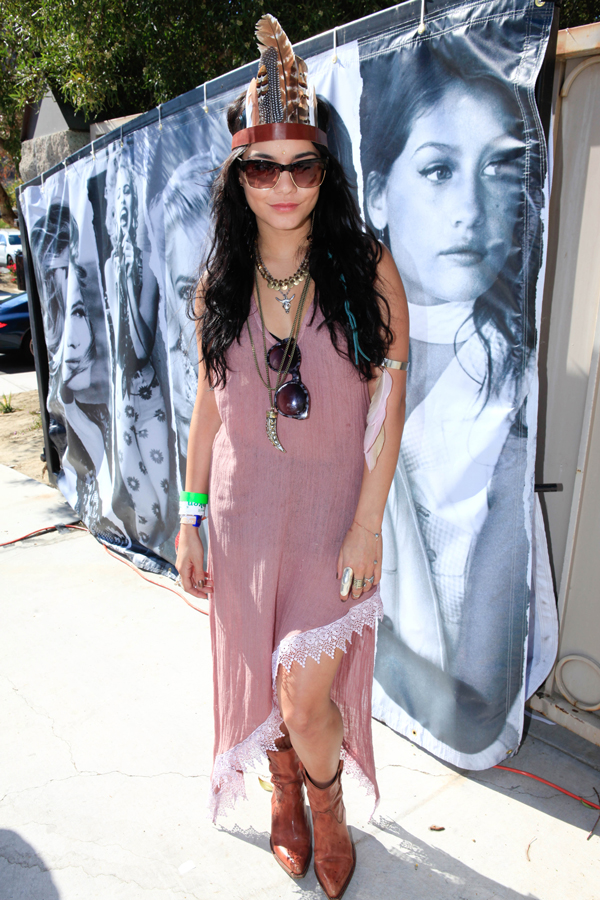Festival goers misappropriate culture
Weekend one of Coachella has come and gone, and by the time this column goes to print, weekend two will well be on its way. If you’re reading this column now and are planning on going to Coachella, leave. Parking is a b–ch.
Aside from parking (it literally took as much time driving from Los Angeles to Indio as it did to get in and out of the parking lot on day one), something troubling has been on my mind. I’m deeply bothered by the misappropriation of Native American culture at music festivals, Coachella being the most timely example.
As a young, white middle-class woman, part of me feels that it’s not really my place to speak to this issue as I don’t relate to it personally. Still, I can understand it. Though I am a confirmed Catholic, I’m not particularly religious. But, once in high school I spotted a handful of non-Catholic girls sporting rosaries as necklaces — they were using a religious item meant for the purpose of prayer to make a fashion statement. It really pissed me off and, frankly, it felt very disrespectful. I would hate for someone else to feel the same way.
Back to the matter at hand, if I’m bothered by the misappropriation of headdresses at music festivals, I can only imagine how the people who are directly affected by it feel. For that reason, I felt I needed to further explore this subject.
This trend is nothing new to Coachella, or other music festivals for that matter. But, a few examples stand out from this year. Alessandra Ambrosio and Vanessa Hudgens posted photos of themselves on Instagram wearing Native American headdresses, both of which received backlash. Then, of course, there were multiple non-celebrities wearing headdresses, many of which were lit up in neon (neon?!), at the festival.
Personally, I don’t think these examples come from a place of malice. Rather, I think they come from a place of ignorance. Even so, is it ok? If someone does not intend harm but it happens as a result is it still bad? Yes, absolutely.
USC’s Professor Tok Thompson, who works in the Department of Anthropology, grew up in backwoods Alaska in a community that was about half Native American — at least when he was born, before the oil boom. A number of Thompson’s extended family are Native American as well. For Thompson, Native American culture has had a “tremendous influence” on him.
Quite familiar with the culture, Thompson could not agree more that the misuse of headdresses, even without malicious intent, still have negative consequences, especially because they have deep religious and cultural significance.
“I don’t think it’s ever in good taste to caricature another culture’s ritual and/or religious robes,” Thompson wrote in an email. “Secular apparel is perhaps one thing, but feather headdresses were and are religious and sacred clothing.”
Thompson adds that eagle feathers are sacred symbols for many, if not most, Native American groups. Sacred. Think about that word. Headdresses are sacred, they are deeply significant, and yet festivalgoers wear these pieces as a mere fashion statement, as an accessory to adorn their drug-fueled bodies. They are desecrating years of tradition and cultural importance.
Wearing a headdress might not seem like a big deal. How could one minor fashion statement hurt an entire culture? But in the greater context of Native American treatment and representation, even a small act can fuel the oppression and misrepresentation that Native Americans have experienced for years. Moreover, these “small acts” represent Native Americans in ways that they have not personally chosen to be portrayed. Festival attendees should not speak for an entire group of people.
“Also to be considered is the way in which Native peoples in America have been denied their own voice in media and public presentations, instead being portrayed by the conquerors, depicting them variously as noble savages, savage savages and other sorts of primitive, past-oriented people — especially in the all-American genre of the Western,” Thompson wrote. “This makes the portrayal of them by others particularly fraught with tension, with clear links to the massive historical violence against them, and the continuing ignorance of their real issues.”
Even worse, this issue extends far beyond music festivals. When asked where else Thompson sees this misuse of Native American traditions, he responded, “Just about everywhere. The list is (nearly) endless.”
But there is a solution, and it’s all in our mindset. We’re quick to call ourselves a tolerant society but misappropriating Native American pieces that have deep cultural significance is just one of many examples that prove we have so much more work to do. We need to increase our understanding. We need to read up and learn about the cultures we’re misappropriating. And if that’s not an option, just don’t wear headdresses. If this is all about looking cool on social media, I’m sure your Instagram followers really don’t give a sh-t, so why should you care? It’s just one photo.
“If people want to demonstrate a sympathy and interest in Native American traditions, I can recommend much better ways,” Thompson wrote. “Why not learn a bit of the language of the group in which you’re interested? Many Native American languages have videos on YouTube for the learner. That would demonstrate a true, sustained interest much more than putting on a funny hat.”
He added: “Or, if the point is indeed to put on a funny hat, I would suggest that there are many more suitable choices than this one.”
C. Molly Smith is a senior majoring in communication. Her column, “Art Garfunkel,” ran every other Friday.

